Monthly Archives: January 2018
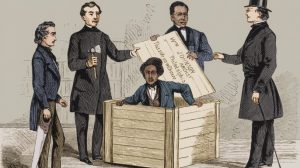 There are times when what you know is what gets you through a bad situation, but there are some situations that really do requiring knowing someone who can help. For the slaves in the pre-emancipation era of the United States, that was as true as it gets. The slaves had none of the most important asset needed for escape…money. That didn’t stop the attempts. One slave who was from the deeper south, Henry “Box” Brown, decided to mail himself to safety. That did work, but not everyone had the ability to get that done, and so the majority just decided to make a run for it…only to be met by dogs or Bounty Hunters…neither was going to have a good outcome.
There are times when what you know is what gets you through a bad situation, but there are some situations that really do requiring knowing someone who can help. For the slaves in the pre-emancipation era of the United States, that was as true as it gets. The slaves had none of the most important asset needed for escape…money. That didn’t stop the attempts. One slave who was from the deeper south, Henry “Box” Brown, decided to mail himself to safety. That did work, but not everyone had the ability to get that done, and so the majority just decided to make a run for it…only to be met by dogs or Bounty Hunters…neither was going to have a good outcome.
One rather famous slave named Mustapha, teamed up with a white hunchback named Arthur Howe and conned his way to freedom. It was probably the most outrageous, and yet the best planned escape there was. The plan was simple, the pair traveled through North Carolina and Virginia, telling anyone they met that Mustapha was Howe’s slave. Since Howe was famous for his fearsome appearance and “expressive of dark angry passions,” that few people dared to ask any more questions. Whenever Howe and Mustapha, reached a town, Howe would sell Mustapha for a tidy fee. After a few days recuperating, Mustapha would escape again and the partners would resume their journey. Not only did this help avoid bounty hunters, who would be looking for an escaped slave, rather than a current one, it brought in a tidy profit as well. Mustapha was quite a brave man. He was not worried that he would not be able to escape the people he was sold too. Most slaves struggled to escape once…Mustapha did it every week. 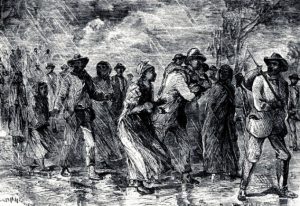 He also had to trust Howe to continue to be there waiting for him so they could continue their journey.
He also had to trust Howe to continue to be there waiting for him so they could continue their journey.
The plan worked perfectly and as planned the pair parted ways, after reaching Petersburg or Richmond. This put Mustapha free to make his escape north. Since he was not apprehended, it is believed that this was what happened. No one is exactly positive about that, but the duo dropped out of history after that, so it is believed to be the way everything went down. When we look back on the many deaths that followed an escape attempt, I have to think that it is sad that more slaves didn’t think of this idea. I’m sure the many slave owners who were scammed though, I think there was a little justice in the world after all.
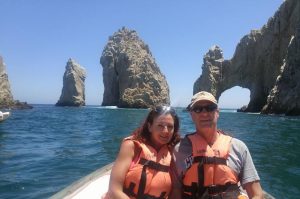
 My niece, Toni Chase has become a world traveler since her marriage to Dave. She and Dave love going places. Whether it’s Hawaii, or the Caribbean, they spend as much time traveling as they can. They decided to get a time share, and while most people who have a time share, end up selling it because they don’t really use it, that is not the case with Toni and Dave. They love theirs and they use it often. They just pick a date, and look and the available sites, and register for their dates. If a person thinks they like to travel, but really isn’t sure, time shares are probably not the best thing to have, but for Toni and Dave, it was perfect, and they use it a lot. in fact, they went to Mexico in June.
My niece, Toni Chase has become a world traveler since her marriage to Dave. She and Dave love going places. Whether it’s Hawaii, or the Caribbean, they spend as much time traveling as they can. They decided to get a time share, and while most people who have a time share, end up selling it because they don’t really use it, that is not the case with Toni and Dave. They love theirs and they use it often. They just pick a date, and look and the available sites, and register for their dates. If a person thinks they like to travel, but really isn’t sure, time shares are probably not the best thing to have, but for Toni and Dave, it was perfect, and they use it a lot. in fact, they went to Mexico in June.
For Toni, family comes first. Her boys are the most important part of her life. She had a son, James Renville from her first marriage, and while Dave loves James, and is a big part of his life, he would never try to replace James’ real dad. I think it is the respect shown on both sides of that split, that has made it a very good relationship for all of them. Of course, a good relationship between blended families is only possible if everyone works together, and for this group the respect, cooperation, and a genuine love for James. And isn’t that really what good parents do…the best thing for the kids.
This has been an interesting year for Toni. Dave has spent much of his time playing softball and basketball, and 
 apparently that’s a little hard on Toni. I don’t know if it was heavy duty cheering, or what, but Toni ended up having hernia surgery. During the surgery, they found that the appendix was caught in the hernia, and it had to be removed too. It wasn’t Dave’s sports that caused Toni’s need for surgery, but Toni is a great cheerleader when it come to the sports and activities of her boys. I think she pretty much likes anything they are doing. Of course when it comes to what Toni is doing, Dave like most husbands, Dave couldn’t tell you what she has been up to. Toni has recently become interested in Wyoming history. Maybe she is a chip off of her Aunt Caryn’s block. She says that it’s very addictive. I agree. Today is Toni’s birthday. Happy birthday Toni!! Have a great day!! We love you!!
apparently that’s a little hard on Toni. I don’t know if it was heavy duty cheering, or what, but Toni ended up having hernia surgery. During the surgery, they found that the appendix was caught in the hernia, and it had to be removed too. It wasn’t Dave’s sports that caused Toni’s need for surgery, but Toni is a great cheerleader when it come to the sports and activities of her boys. I think she pretty much likes anything they are doing. Of course when it comes to what Toni is doing, Dave like most husbands, Dave couldn’t tell you what she has been up to. Toni has recently become interested in Wyoming history. Maybe she is a chip off of her Aunt Caryn’s block. She says that it’s very addictive. I agree. Today is Toni’s birthday. Happy birthday Toni!! Have a great day!! We love you!!

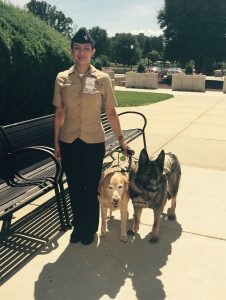 My niece, Gabby Beach finished her service in the Navy, and now it is her time to finish her education. Gabby was a corpsman in the Navy, and so have decided to go for a nursing degree. She and her husband, Allen decided to make Casper, Wyoming their home for the college years, because Casper College has a great nursing program, and it places them close to family…something they haven’t had since they joined the Navy. This semester will find Gabby taking the prerequisites, for the nursing program, which is no small class load. In addition, she will be taking a PE class, which, for Gabby, is a walk in the park. She is a fitness fanatic. She looks great, and she could take on any physical challenge issued. In fact, she is also taking the certification to become a personal trainer. I think it would be very easy for Gabby to have three careers. Nursing, Personal Trainer, and Dog Training for service dogs. She is quite good at all three.
My niece, Gabby Beach finished her service in the Navy, and now it is her time to finish her education. Gabby was a corpsman in the Navy, and so have decided to go for a nursing degree. She and her husband, Allen decided to make Casper, Wyoming their home for the college years, because Casper College has a great nursing program, and it places them close to family…something they haven’t had since they joined the Navy. This semester will find Gabby taking the prerequisites, for the nursing program, which is no small class load. In addition, she will be taking a PE class, which, for Gabby, is a walk in the park. She is a fitness fanatic. She looks great, and she could take on any physical challenge issued. In fact, she is also taking the certification to become a personal trainer. I think it would be very easy for Gabby to have three careers. Nursing, Personal Trainer, and Dog Training for service dogs. She is quite good at all three.
Another nice thing about moving to Wyoming for school, is the fact that there are lots of places to go hiking, and that is something that Gabby and Allen like to do. They have traveled the world, and I’m sure they have hiked lots of places too. I’m sure that Wyoming is pretty unique when compared to the places they have lived. While Wyoming has its own kind of beauty, I’m sure it is much more rustic than any other place they have lived. They have settled in an apartment on my sister, Caryl Reed, and her husband Mike’s retirement home outside of Casper, and they are really enjoying the quietness of country living. I don’t think that any of the places Gabby has lived before go much snow, and she was out shoveling and seemingly having a good time 
 doing it. Most of us, who have lived in Wyoming for any length of time, know that shoveling snow is pretty low on the list of things most fun to do. But, once again, Gabby has proven that she is not most people. She tends to embrace to unknown or unusual.If she were like most people, I have a feeling that she would not have loved to exercise either. I have a feeling that it was Gabby’s uniqueness that first attracted Allen to her…other that her beauty. And Gabby is beautiful. Today is Gabby’s birthday. Happy birthday Gabby!! Have a great day!! We love you!!
doing it. Most of us, who have lived in Wyoming for any length of time, know that shoveling snow is pretty low on the list of things most fun to do. But, once again, Gabby has proven that she is not most people. She tends to embrace to unknown or unusual.If she were like most people, I have a feeling that she would not have loved to exercise either. I have a feeling that it was Gabby’s uniqueness that first attracted Allen to her…other that her beauty. And Gabby is beautiful. Today is Gabby’s birthday. Happy birthday Gabby!! Have a great day!! We love you!!
 The Vietnam war was many things, but I don’t think anyone really expected Operation Ranch Hand…at least not the general public. Who would have expected such a heinous act to be carried out by the government. Operation Ranch Hand was a United States military operation during the Vietnam War, lasting from 1962 until 1971. The operation was largely inspired by the British use of 2,4,5-T and 2,4-D (Agent Orange) during the Malayan Emergency in the 1950s. It was part of the overall program during the war called “Operation Trail Dust.” Ranch Hand involved spraying an estimated 20 million United States gallons of defoliants and herbicides over rural areas of South Vietnam in an attempt to deprive the Viet Cong of food and vegetation cover. Nearly 20,000 sorties were flown between 1961 and 1971.
The Vietnam war was many things, but I don’t think anyone really expected Operation Ranch Hand…at least not the general public. Who would have expected such a heinous act to be carried out by the government. Operation Ranch Hand was a United States military operation during the Vietnam War, lasting from 1962 until 1971. The operation was largely inspired by the British use of 2,4,5-T and 2,4-D (Agent Orange) during the Malayan Emergency in the 1950s. It was part of the overall program during the war called “Operation Trail Dust.” Ranch Hand involved spraying an estimated 20 million United States gallons of defoliants and herbicides over rural areas of South Vietnam in an attempt to deprive the Viet Cong of food and vegetation cover. Nearly 20,000 sorties were flown between 1961 and 1971.
It’s hard to say if the government knew the consequences of the chemicals that were used. It’s possible that the chemicals were thought to just kill vegetation, and not to hurt people. The people involved were known as 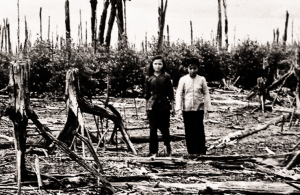 Ranch Handers. I seriously doubt that at some point they didn’t wonder if what they were doing could possibly be harmful to the people they were spraying it on or near. Nevertheless, the “Ranch Handers” had a motto, “Only you can prevent a forest.” It was a take on the popular United States Forest Service poster slogan of Smokey Bear. During the ten years of spraying, over 5 million acres of forest and 500,000 acres of crops were heavily damaged or destroyed. Around 20% of the forests of South Vietnam were sprayed at least once.
Ranch Handers. I seriously doubt that at some point they didn’t wonder if what they were doing could possibly be harmful to the people they were spraying it on or near. Nevertheless, the “Ranch Handers” had a motto, “Only you can prevent a forest.” It was a take on the popular United States Forest Service poster slogan of Smokey Bear. During the ten years of spraying, over 5 million acres of forest and 500,000 acres of crops were heavily damaged or destroyed. Around 20% of the forests of South Vietnam were sprayed at least once.
The herbicides were sprayed by the United States Air Force flying C-123s using the call sign “Hades.” The planes were fitted with specially developed spray tanks with a capacity of 1,000 United States gallons of herbicides. A plane sprayed a swath of land that was ½ mile wide and 10 miles long in about 4½ minutes, at a rate of about 3 United States gallons per acre. Sorties usually consisted of three to five airplanes flying side by  side, and 95% of the herbicides and defoliants used in the war were sprayed by the United States Air Force as part of Operation Ranch Hand. The remaining 5% were sprayed by the United States Chemical Corps, other military branches, and the Republic of Vietnam using hand sprayers, spray trucks, helicopters and boats, primarily around United States military installations…meaning that the majority of the chemicals were exposed to the Untied States Military. Many of the Vietnam veterans have felt betrayed by their own government. Many have felt that the government was well aware of the dangers of the chemicals they were spraying. I don’t know if they knew or not, but it seems like they should have suspected something. Years later, the effects of Agent Orange are well known and it was vicious.
side, and 95% of the herbicides and defoliants used in the war were sprayed by the United States Air Force as part of Operation Ranch Hand. The remaining 5% were sprayed by the United States Chemical Corps, other military branches, and the Republic of Vietnam using hand sprayers, spray trucks, helicopters and boats, primarily around United States military installations…meaning that the majority of the chemicals were exposed to the Untied States Military. Many of the Vietnam veterans have felt betrayed by their own government. Many have felt that the government was well aware of the dangers of the chemicals they were spraying. I don’t know if they knew or not, but it seems like they should have suspected something. Years later, the effects of Agent Orange are well known and it was vicious.
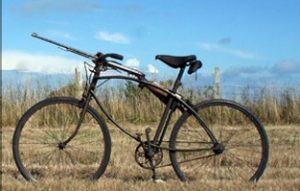
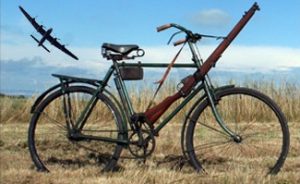 When we think about war machines, we think of planes, tanks, ships, and even horses, but we very seldom…if ever, think of bicycles. Nevertheless, bicycles were used in a number of wars, and even continue to be used to this day. The late 19th century brought several experiments into the possible role of bicycles and cycling within military establishments, primarily because they can carry more equipment and travel longer distances than walking soldiers could. The development of pneumatic tires coupled with shorter, sturdier frames in the late 19th century led military establishments to investigate the possibility of bicycles in combat. To some extent, bicyclists took over the functions of dragoons, especially as messengers and scouts, substituting for horses in warfare. Bicycle units or detachments were in existence by the end of the 19th century in most armies.
When we think about war machines, we think of planes, tanks, ships, and even horses, but we very seldom…if ever, think of bicycles. Nevertheless, bicycles were used in a number of wars, and even continue to be used to this day. The late 19th century brought several experiments into the possible role of bicycles and cycling within military establishments, primarily because they can carry more equipment and travel longer distances than walking soldiers could. The development of pneumatic tires coupled with shorter, sturdier frames in the late 19th century led military establishments to investigate the possibility of bicycles in combat. To some extent, bicyclists took over the functions of dragoons, especially as messengers and scouts, substituting for horses in warfare. Bicycle units or detachments were in existence by the end of the 19th century in most armies.
By World War I, the level terrain in Belgian was well used by military cyclists, prior to the onset of trench 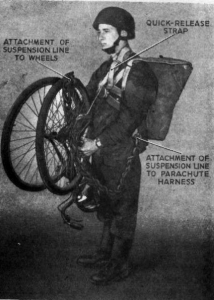 warfare. Each of the four Belgian carabinier battalions included a company of cyclists, equipped with a brand of folding, portable bicycle named the Belgica. A regimental cyclist school gave training in map reading, reconnaissance, reporting, and the carrying of verbal messages. Attention was paid to the maintenance and repair of the machine itself. The bicycle could be used to ride when it was feasible, and carried when the pat was not suitable to riding. The bicycle made no noise, so unless the trail was littered with twigs, the bicycle make very little noise. Sneaking up on the enemy was possible.
warfare. Each of the four Belgian carabinier battalions included a company of cyclists, equipped with a brand of folding, portable bicycle named the Belgica. A regimental cyclist school gave training in map reading, reconnaissance, reporting, and the carrying of verbal messages. Attention was paid to the maintenance and repair of the machine itself. The bicycle could be used to ride when it was feasible, and carried when the pat was not suitable to riding. The bicycle made no noise, so unless the trail was littered with twigs, the bicycle make very little noise. Sneaking up on the enemy was possible.
In the United States, the most extensive experimentation on bicycle units was carried out by 1st Lieutenant Moss, of the 25th United States Infantry (Colored), which was made up of African American infantry soldiers with European American officers. Using a variety of cycle models, Moss and his troops carried out extensive bicycle journeys covering between 800 and 1,900 miles. Late in the 19th century, the United States Army tested the bicycle’s suitability for cross-country troop transport. Buffalo Soldiers stationed in Montana rode bicycles across roadless landscapes for hundreds of miles at high speed. The “wheelmen” traveled the 1,900 Miles to Saint Louis, Missouri in 34 days with an average speed of over 6 miles per hour. The bicycles were even used in the paratrooper deployment. These bicycles not only folded up, but they were equipped with an on board rifle. I don’t know how hard it was to handle a gun while riding a bike, but I’m sure it was a relief to have your gun right there.
The first known use of the bicycle in combat occurred during the Jameson Raid, in which cyclists carried messages. In the Second Boer War, military cyclists were used primarily as scouts and messengers. One unit 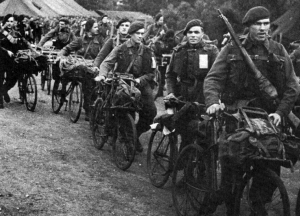 patrolled railroad lines on specially constructed tandem bicycles that were fixed to the rails. Several raids were conducted by cycle-mounted infantry on both sides; the most famous unit was the Theron se Verkenningskorps (Theron Reconnaissance Corps) or TVK, a Boer unit led by the scout Daniel Theron, whom British commander Lord Roberts described as “the hardest thorn in the flesh of the British advance.” Roberts placed a reward of £1,000 on Theron’s head…dead or alive…and dispatched 4,000 soldiers to find and eliminate the TVK. While scouting alone on a road near Gatsrand, about 3.7 miles north of present-day Fochville, he encountered seven members of Marshall’s Horse and was killed in action.
patrolled railroad lines on specially constructed tandem bicycles that were fixed to the rails. Several raids were conducted by cycle-mounted infantry on both sides; the most famous unit was the Theron se Verkenningskorps (Theron Reconnaissance Corps) or TVK, a Boer unit led by the scout Daniel Theron, whom British commander Lord Roberts described as “the hardest thorn in the flesh of the British advance.” Roberts placed a reward of £1,000 on Theron’s head…dead or alive…and dispatched 4,000 soldiers to find and eliminate the TVK. While scouting alone on a road near Gatsrand, about 3.7 miles north of present-day Fochville, he encountered seven members of Marshall’s Horse and was killed in action.
 My grandniece, Siara Harman is a tiny little girl, just 4 feet 9 inches tall, but don’t let that fool you, because she is one tough cookie. She works out, and she’s really strong. After high school, Siara spent a year in Great Falls, Montana going to school, and representing the college as a cheerleader. During that year, she worked out and cheered at a pace most of us would find exhausting. Nevertheless, Siara took it all on stride. After that year, Siara returned home, mostly because she missed her family, I think…especially her mom, but also to continue her studies in her home town.
My grandniece, Siara Harman is a tiny little girl, just 4 feet 9 inches tall, but don’t let that fool you, because she is one tough cookie. She works out, and she’s really strong. After high school, Siara spent a year in Great Falls, Montana going to school, and representing the college as a cheerleader. During that year, she worked out and cheered at a pace most of us would find exhausting. Nevertheless, Siara took it all on stride. After that year, Siara returned home, mostly because she missed her family, I think…especially her mom, but also to continue her studies in her home town.
Siara is the type of person who takes time to decide to commit to most things, but once she does, she is all in. After her mom, my niece, Chantel Balcerzak remarried, it took Siara 18 months before she started calling her step-dad, Dave Balcerzak, “Dad.”  Her brother, Jake Harman was much quicker to accept his step-dad. Nevertheless, once Siara committed to calling Dave “Dad,” she was in, wholeheartedly, and as far as she is concerned, Dave is her dad. Commitment, while not forthcoming, is something Siara takes very seriously.
Her brother, Jake Harman was much quicker to accept his step-dad. Nevertheless, once Siara committed to calling Dave “Dad,” she was in, wholeheartedly, and as far as she is concerned, Dave is her dad. Commitment, while not forthcoming, is something Siara takes very seriously.
Over the years, Siara has had a number of boyfriends, but once again she was very slow to commit to any of them. Siara was in two serious relationships before her current relationship, but once the conversation turned to marriage, her mom could always tell that it was, “Nope, not yet.” Her heart couldn’t move in that direction yet. With her fiancé, Nick Olsen, things would be different. While she and Nick have been dating for a while now, it took Siara only two week to tell her mom that, “No matter when he asks, the answer is yes.” I guess that when it’s the right one, commitment is easy. Siara and Nick will be married this summer.

As I said, Siara is a tiny, short little girl, and I recall that a few years ago…before she was “fully” grown, she told me that she wanted to be 5 feet 7 inches tall…an impossibility for our little Siara, who is full grown at 4 feet 9 inches. Knowing that she would never achieve that lofty goal, I told her to wear high heels, because that was going to be the only way she would ever be taller. She took my advise, and these days, with heels she is over 5 feet, anyway. Siara has decided that she is not going to take that chance with there kids, so she is going to marry a tall man. Of course, it wasn’t his height that won Siara’s love, but rather his heart. Still, Nick’s height was not a negative to Sara, even if he practically has to pick her up to kiss her. The really good news is that since Siara loves a very tall man, her kids might have a chance to be taller than she is. I guess that’s some consolation to Siara’s height dilemma. Today is Siara’s birthday. Happy birthday Siara!! Have a great day!! We love you!!

 My grandnephew, Ethan Hadlock is a sweet boy. He is always ready to hand out the hugs to all the people he cares about. Ethan is the oldest of my sister, Allyn and her husband, Chris Hadlock’s grandchildren, and the only boy, so he is pretty protective of his little girl cousins, Adelaide Sawdon and McKenzie Moore, and his sister, Aurora Hadlock. It’s what being the boy in the family is all about. Ethan has a soft heart and it shows in everything he does. Ethan turned 9 years old today. I have a really hard time thinking that he could possibly be 9 years old already. He is a good student and works really hard in his classes. He is a really great reader, and he has been known to practice his reading on his little sister, so as he practiced, and she got to hear the story. She is learning to read too now, so I don’t suppose he has to read to her much these days. Ethan is such a kind boy that he won the Kindness Award at his school.
My grandnephew, Ethan Hadlock is a sweet boy. He is always ready to hand out the hugs to all the people he cares about. Ethan is the oldest of my sister, Allyn and her husband, Chris Hadlock’s grandchildren, and the only boy, so he is pretty protective of his little girl cousins, Adelaide Sawdon and McKenzie Moore, and his sister, Aurora Hadlock. It’s what being the boy in the family is all about. Ethan has a soft heart and it shows in everything he does. Ethan turned 9 years old today. I have a really hard time thinking that he could possibly be 9 years old already. He is a good student and works really hard in his classes. He is a really great reader, and he has been known to practice his reading on his little sister, so as he practiced, and she got to hear the story. She is learning to read too now, so I don’t suppose he has to read to her much these days. Ethan is such a kind boy that he won the Kindness Award at his school.
Ethan has lofty goals for a boy in the 3rd grade. He has decided that he wants to be a Marine, so he can kill  bad guys. I never would have expected the Marines, but his desire to fight crime and terrorism is not surprising, because Ethan’s grandpa, Chris Hadlock is a retired Casper Police Department Lieutenant, and his uncle, Jason Sawdon is a Wyoming Highway Patrol Officer. Both of them are decorated, and I know that Ethan is very proud of them. After his time in the Marines, it wouldn’t surprise me to see Ethan become a cop in some branch of law enforcement. Sometimes this kind of thing runs in families, and it almost like it is in their blood.
bad guys. I never would have expected the Marines, but his desire to fight crime and terrorism is not surprising, because Ethan’s grandpa, Chris Hadlock is a retired Casper Police Department Lieutenant, and his uncle, Jason Sawdon is a Wyoming Highway Patrol Officer. Both of them are decorated, and I know that Ethan is very proud of them. After his time in the Marines, it wouldn’t surprise me to see Ethan become a cop in some branch of law enforcement. Sometimes this kind of thing runs in families, and it almost like it is in their blood.
Of course, Ethan doesn’t spend all his time working toward becoming a Marine. He does have to spend some time being a kid. Ethan, like many kids, likes video games, and his favorite is Minecraft. For those, like me, who had no idea what the game is all about, it is a game about digging (mine) and building (craft). Basically you build buildings, so similar to construction. Maybe Ethan will become an architect. I think he would be good at that too. Ethan is really a kid with a wide variety of interests. I suppose that comes from being such a good student. He has taken the time to broaden his horizons, so to speak.

 Ethan has a great sense of humor, and loves to pick on his Great Aunt Caryn, by flipping my long hair on top of my head from time to time, and then pretending that it wasn’t him. When I can’t catch him at it, he just laughs and laughs. I’m quite sure that he uses his teasing prowess on his aunts, uncles, and grandparents too, if I know him. In all, Ethan is probably a normal 9 year old, but in many ways I think he is pretty exceptional. Today is Ethan’s 9th birthday. Happy birthday Ethan!! Have a great day!! We love you!!
Ethan has a great sense of humor, and loves to pick on his Great Aunt Caryn, by flipping my long hair on top of my head from time to time, and then pretending that it wasn’t him. When I can’t catch him at it, he just laughs and laughs. I’m quite sure that he uses his teasing prowess on his aunts, uncles, and grandparents too, if I know him. In all, Ethan is probably a normal 9 year old, but in many ways I think he is pretty exceptional. Today is Ethan’s 9th birthday. Happy birthday Ethan!! Have a great day!! We love you!!
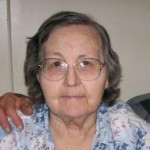
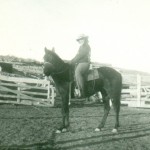 My mother-in-law, Joann Schulenberg has always been a tough lady, and I suppose that is why we found it so hard to believe that she would not win this final battle in her life. She bounced back so many times, when we all thought she was going for sure, but in the end, it was not the things we expected to take her life, like COPD or diabetes, that actually did so, but rather kidney failure, complicated by congestive heart failure. Through all of the many episodes of illness in her life, we were amazed at the strength she displayed while fighting her way back to where she had been before getting sick. This final battle would be different. She was tired, and she was ready to go home to Heaven. And while we were very sad and hated to let her go, we could not ask her to stay. She had suffered long enough.
My mother-in-law, Joann Schulenberg has always been a tough lady, and I suppose that is why we found it so hard to believe that she would not win this final battle in her life. She bounced back so many times, when we all thought she was going for sure, but in the end, it was not the things we expected to take her life, like COPD or diabetes, that actually did so, but rather kidney failure, complicated by congestive heart failure. Through all of the many episodes of illness in her life, we were amazed at the strength she displayed while fighting her way back to where she had been before getting sick. This final battle would be different. She was tired, and she was ready to go home to Heaven. And while we were very sad and hated to let her go, we could not ask her to stay. She had suffered long enough.
Throughout the years that Joann was my mother-in-law, she was an inspiration to many people. She had the ability to do so many things…knitting, crocheting, sewing, canning, and oh, her baking!! Mom could make a “Murder Cake” that could easily destroy any diet, because it was irresistible. “Murder Cake” was a chocolate cake with so much gooey, yummy fudge that the frosting became a part of the gooey cake. Maybe it was called “Murder Cake” because it murdered your diet. It was also my mother-in-law who introduced me to Squash and Pancakes, a dish that sounds like it should be awful, but one bite, and you are hooked. My husband, Bob; daughter, Amy; and I look forward to summer just for the squash and pancakes.
Having been raised in the country or small towns, the country was where Joann felt mostly at home. It was where she raised her children, and where one of them still lives today. She felt like it was easier to keep track of all those kids, if she had them out in the country, and when the family lived in Mills while the older children were in grade school, she finally told my father-in-law, Walt, that he needed to get the family back out in the country. And so he did. For the first 23 years of my marriage into the family, that is where they lived, and then because of health issues, they made a trade for a house in Casper…right on one of the busiest intersections in town…13th and McKinley Streets. While my mother-in-law said she hated the noise of the traffic and many emergency vehicles, she sure loved to look out the window to see what was going on out there. She secretly enjoyed the flurry of activity that was always going on out on the busy streets, and while Alzheimer’s Disease 
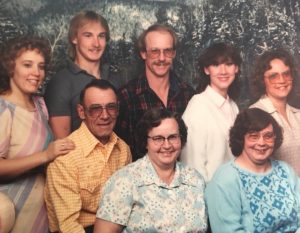 might have taken her most recent memories away, she always had her favorite pastime…people watching, whether they be in traffic, walking, or on television. My mother-in-law’s Alzheimer’s Disease was the kind that kept the funniest things in life in the forefront of her memory, and she could say the funniest things. While she might not remember our names, she always knew that her children and grandchildren belonged to her, and for that we are forever grateful. Rest in peace Mom, we miss you already, and we love you forever.
might have taken her most recent memories away, she always had her favorite pastime…people watching, whether they be in traffic, walking, or on television. My mother-in-law’s Alzheimer’s Disease was the kind that kept the funniest things in life in the forefront of her memory, and she could say the funniest things. While she might not remember our names, she always knew that her children and grandchildren belonged to her, and for that we are forever grateful. Rest in peace Mom, we miss you already, and we love you forever.
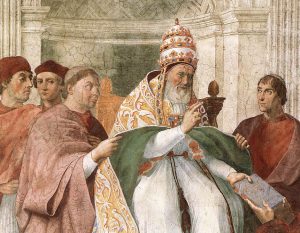 Sometimes, people can associate certain things with certain religions, and even Satanism. They can then make decisions on life based on what they perceive something to be. Unfortunately, sometimes those decisions end up being disastrous. Such was the case with Pope George IX, who decided that cats where a part of devil worship, and so ruled that cats should be exterminated. Cats throughout Europe were exterminated in droves immediately thereafter. Of course, we know that while some religions might use certain animals in their religious practices, that does not make the animal evil…but rather, the animal is a victim of that religion, much like people in certain religions use snakes as a part of worship.
Sometimes, people can associate certain things with certain religions, and even Satanism. They can then make decisions on life based on what they perceive something to be. Unfortunately, sometimes those decisions end up being disastrous. Such was the case with Pope George IX, who decided that cats where a part of devil worship, and so ruled that cats should be exterminated. Cats throughout Europe were exterminated in droves immediately thereafter. Of course, we know that while some religions might use certain animals in their religious practices, that does not make the animal evil…but rather, the animal is a victim of that religion, much like people in certain religions use snakes as a part of worship.
After the cats were removed from Europe, an unexpected and horrific side effect occurred. The sudden lack of cats led to the spread of disease because infected rats ran free. The most devastating of these diseases, the Bubonic Plague, killed 100 million people. Pope Gregory lived from 1145 to 1241, AD, so little was known about how disease was passed. He was born Ugolino di Conti but took the name Gregory when he became the pope. That was when Ugolino was over 80 years old, not a young age to take on the papal role.
The cat fiasco is just one part of Pope Gregory IX’s story. He is mostly known for issuing the Decretals and starting the Papal Inquisition. The Decretals reorganized the whole library of Catholic laws. The papal inquisition rained down justice on heretics, the people who spoke out against the church. It was Gregory’s past 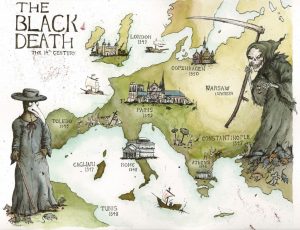 as a lawyer that connected him to his acts of justice within the church. It was his distaste for cats that penned the Vox in Rama (the papal decree – this one about the cats). That was the first church document condemning black cats as instruments of satan. By Gregory’s decree, there was a target on the head of every black cat. The Black Death or Black Plague was the original zombie apocalypse. People living during this time lived in constant fear of death. Many believed this was the end of the human race, and that is understandable. It was one of the most deadly pandemics in history. By rough estimates, as many as 200 million people died. If you survived, you lost many loved ones, and in Europe, it was all because of a lack of cats.
as a lawyer that connected him to his acts of justice within the church. It was his distaste for cats that penned the Vox in Rama (the papal decree – this one about the cats). That was the first church document condemning black cats as instruments of satan. By Gregory’s decree, there was a target on the head of every black cat. The Black Death or Black Plague was the original zombie apocalypse. People living during this time lived in constant fear of death. Many believed this was the end of the human race, and that is understandable. It was one of the most deadly pandemics in history. By rough estimates, as many as 200 million people died. If you survived, you lost many loved ones, and in Europe, it was all because of a lack of cats.
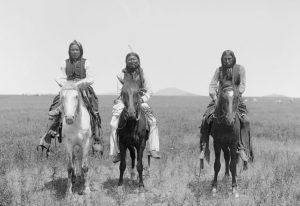 The battle for lands owned, desired, or presumed owned, is one that has raged in the United States for many, many years. When the pilgrims first came to the new world, it did not seem like a problem to the Native Americans, but as more and more “White Men” came, the Native Americans could see the writing on the wall. so to speak. They knew that their wide open spaces were in jeopardy, and they were determined not to lose the battle for their most prized possession…land. In the 18th and 19th centuries settlers from Europe moved westward across America in a steady wave. The migration overwhelmed ancient tribes like the Iroquois, the Cherokee, and the Shawnee. But when the settlers reached Texas and the lands of the Comanche, the migration stopped in it’s tracks. Many of the Indians back then were somewhat like the settlers. They had their villages, and they stayed in one place, or moved slowly from one place to another. The Comanche were just like that, until the horse arrived in North America. But the Comanche adapted to the horse like no other Native American group. They became nomads, following the buffalo, and as they exploded across the Texas plains, they virtually wiped out the Apache. Their enormous horse herds were legendary, as were their riding skills. While the Cheyenne and Sioux would dismount before battles, the Comanche mastered the art of fighting on horseback. They planted no crops, built no settlements, and shunned complex ritual or religion. The name “Comanche” was given to them by the Utes. It means “enemies.”
The battle for lands owned, desired, or presumed owned, is one that has raged in the United States for many, many years. When the pilgrims first came to the new world, it did not seem like a problem to the Native Americans, but as more and more “White Men” came, the Native Americans could see the writing on the wall. so to speak. They knew that their wide open spaces were in jeopardy, and they were determined not to lose the battle for their most prized possession…land. In the 18th and 19th centuries settlers from Europe moved westward across America in a steady wave. The migration overwhelmed ancient tribes like the Iroquois, the Cherokee, and the Shawnee. But when the settlers reached Texas and the lands of the Comanche, the migration stopped in it’s tracks. Many of the Indians back then were somewhat like the settlers. They had their villages, and they stayed in one place, or moved slowly from one place to another. The Comanche were just like that, until the horse arrived in North America. But the Comanche adapted to the horse like no other Native American group. They became nomads, following the buffalo, and as they exploded across the Texas plains, they virtually wiped out the Apache. Their enormous horse herds were legendary, as were their riding skills. While the Cheyenne and Sioux would dismount before battles, the Comanche mastered the art of fighting on horseback. They planted no crops, built no settlements, and shunned complex ritual or religion. The name “Comanche” was given to them by the Utes. It means “enemies.” 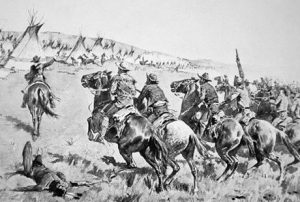
Unfortunately for the Comanche, they were no match for the settlers. After being beaten early on, the Comanche avoided direct conflict for the most part. They preferred to attack undefended farmhouses, slaughtering the inhabitants. It worked, the settlers were too afraid to travel into Comanche territory, and European expansion almost came to a screeching halt. In 1858, after a particularly bloody year, the Texas Rangers were ordered to take care of the Comanche. The empire of the Texas plains was a brutal and unchanging grassland of deadly heat and vast wildfires. No European had traveled very far into the territory, but now the Rangers intended to do just that. They were accompanied by a group of Tonkawas, a local tribe hated by other Native Americans for their cannibalism. The Comanche slaughtered the Tonkawas whenever possible, and the survivors were out for revenge. Together, the Rangers and the Tonkawas traveled for weeks, even fording stretches of pure quicksand, until they discovered a huge Comanche camp stretching along a creek in the Antelope Hills. The Comanche sprang onto their horses, but it was too late. They never expected to be attacked in the heart of the Comancheria and were in no position to fight. It looked as if all was lost, and indeed it was, but they did not know that yet.
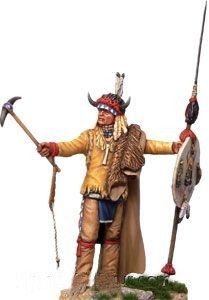
Suddenly, Chief Iron Jacket rode out of the chaos. His true name was Pobishequasso, but he was known as Iron Jacket for his ancient coat of Spanish armor, a family heirloom looted from the corpse of some unlucky conquistador. He exhaled great breaths of air as he rode toward the Rangers, working his medicine, which was said to blow bullets off target. The Rangers and the Tonkawas opened fire, but Iron Jacket kept coming. The bullets seemed to bounce off him, and for a moment, it seemed that he was unstoppable. Then, the magic ended. A hail of rifle fire cut down his horse, and a second volley finished Pobishequasso. His followers…armed only with lances and ancient muskets..fled, pursued by the Rangers, who picked off at least 76 of them. In the years that followed, the settlers became bolder, launching numerous raids into the Comancheria. Iron Jacket’s rusting armor was broken up for souvenirs. The reign of the Comanche was over.

